MaryAnn Bernal's Blog, page 246
August 22, 2014
Archaeologists uncover vast ancient tomb in Greece
Site dates to end of Alexander the Great's reign in 4th century BC and may be grave of a prominent Macedonian, say officials 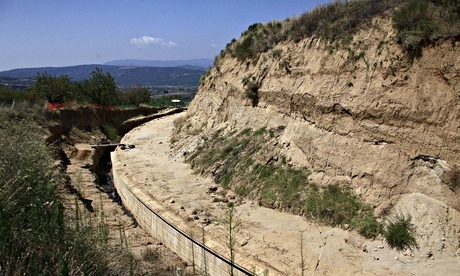
The site where archaeologists are excavating a ancient tomb in Amphipolis, northern Greece. Photograph: Alexandros Michailidis/APArchaeologists have unearthed a vast ancient tomb in Greece, distinguished by two sphinxes and frescoed walls and dating to 300-325BC, the government announced on Tuesday.
The tomb, in the country's north-eastern Macedonia region, which has been gradually unearthed over the past two years, marks a significant discovery from the early Hellenistic era. A culture ministry official said that there was no evidence yet to suggest a link to Alexander the Great – who died in 323BC after an unprecedented military campaign through the Middle East, Asia and northeast Africa – or his family.
The official said the Amphipolis site, about 65 miles north-east of Greece's second-biggest city, Thessaloniki, appeared to be the largest ancient tomb to have been discovered in Greece.
Archaeologists began excavating the site in 2012 and expect to enter the tomb by the end of the month to determine who was buried there.
"It looks like the tomb of a prominent Macedonian of that era," said a second culture ministry official. Alexander the Great died in Babylonia, in modern Iraq, and his actual burial place is not known.
Archaeologists have found two sphinxes, thought to have guarded the tomb's entrance, and a 4.5-metre-wide road leading into it, with walls on both sides covered by frescoes. It is circled by a 497-metre marble outer wall.
Experts believe a five-metre-tall lion sculpture previously discovered nearby once stood atop the tomb.
"It is certain that we stand before an especially significant finding. The land of Macedonia continues to move and surprise us, revealing its unique treasures," the prime minister, Antonis Samaras, said on Tuesday during a visit to the site.
http://www.theguardian.com/science/2014/aug/12/archaeologists-greece-tomb-alexander-great

The site where archaeologists are excavating a ancient tomb in Amphipolis, northern Greece. Photograph: Alexandros Michailidis/APArchaeologists have unearthed a vast ancient tomb in Greece, distinguished by two sphinxes and frescoed walls and dating to 300-325BC, the government announced on Tuesday.
The tomb, in the country's north-eastern Macedonia region, which has been gradually unearthed over the past two years, marks a significant discovery from the early Hellenistic era. A culture ministry official said that there was no evidence yet to suggest a link to Alexander the Great – who died in 323BC after an unprecedented military campaign through the Middle East, Asia and northeast Africa – or his family.
The official said the Amphipolis site, about 65 miles north-east of Greece's second-biggest city, Thessaloniki, appeared to be the largest ancient tomb to have been discovered in Greece.
Archaeologists began excavating the site in 2012 and expect to enter the tomb by the end of the month to determine who was buried there.
"It looks like the tomb of a prominent Macedonian of that era," said a second culture ministry official. Alexander the Great died in Babylonia, in modern Iraq, and his actual burial place is not known.
Archaeologists have found two sphinxes, thought to have guarded the tomb's entrance, and a 4.5-metre-wide road leading into it, with walls on both sides covered by frescoes. It is circled by a 497-metre marble outer wall.
Experts believe a five-metre-tall lion sculpture previously discovered nearby once stood atop the tomb.
"It is certain that we stand before an especially significant finding. The land of Macedonia continues to move and surprise us, revealing its unique treasures," the prime minister, Antonis Samaras, said on Tuesday during a visit to the site.
http://www.theguardian.com/science/2014/aug/12/archaeologists-greece-tomb-alexander-great

Published on August 22, 2014 16:22
2,100-year-old king's mausoleum discovered in China
By Owen Jarus
 Archaeologists in China have discovered a mausoleum, dating back over 2,100 years, that contains three main tombs, including the tomb of Liu Fei (shown at bottom), the ruler of the Jiangdu kingdom in China.Photo courtesy Chinese Archaeology
Archaeologists in China have discovered a mausoleum, dating back over 2,100 years, that contains three main tombs, including the tomb of Liu Fei (shown at bottom), the ruler of the Jiangdu kingdom in China.Photo courtesy Chinese Archaeology
A 2,100-year-old mausoleum built for a king named Liu Fei has been discovered in modern-day Xuyi County in Jiangsu, China, archaeologists report.
Liu Fei died in 128 B.C. during the 26th year of his rule over a kingdom named Jiangdu, which was part of the Chinese empire.
Although the mausoleum had been plundered, archaeologists found that it still contained more than 10,000 artifacts, including treasures made of gold, silver, bronze, jade and lacquer. They also found severallife-size chariot and dozens of smaller chariots.
Excavated between 2009 and 2011, the mausoleum contains "three main tombs, 11 attendant tombs, two chariot-and-horse pits, two weaponry pits" and the remains of an enclosure wall that originally encompassed the complex, a team of Nanjing Museum archaeologists said in an article recently published in the journal Chinese Archaeology. The wall was originally about 1,608 feet long on each side. [See Photos of the Ancient Mausoleum and Artifacts]
The archaeologists said their work was a "rescue excavation," as the site was threatened by quarrying.
Liu Fei's tombA large earthen mound extending more than 492 feet once covered the king's tomb, the archaeologists say. The tomb has two long shafts leading to a burial chamber that measured about 115 feet long by 85 feet wide.
When archaeologists entered the burial chamber they found that Liu Fei was provided with a vast assortment of goods for the afterlife.
Such goods would have been fitting for such a "luxurious" ruler. "Liu Fei admired daring and physical prowess. He built palaces and observation towers and invited to his court all the local heroes and strong men from everywhere around," wrote ancient historian Sima Qian (145-86 B.C.), as translated by Burton Watson. "His way of life was marked by extreme arrogance and luxury."
His burial chamber is divided into a series of corridors and small chambers. The chamber contained numerous weapons, including iron swords, spearheads, crossbow triggers, halberds (a two-handled pole weapon), knives and more than 20 chariot models (not life-size).
The archaeologists also found musical instruments, including chime bells, zither bridges (the zither is a stringed instrument) and jade tuning pegs decorated with a dragon design.
Liu Fei's financial needs were not neglected, as the archaeologists also found an ancient "treasury" holding more than 100,000 banliang coins, which contain a square hole in the center and were created by the first emperor of China after the country was unified. After the first emperor died in 210 B.C., banliang coins eventually fell out of use. [Photos: Ancient Chinese Warriors Protect Secret Tomb of First Emperor]
In another section of the burial chamber archaeologists found "utilities such as goose-shaped lamps, five-branched lamps, deer-shaped lamps, lamps with a chimney or with a saucer ." They also found a silver basin containing the inscription of "the office of the Jiangdu Kingdom."
The king was also provided with a kitchen and food for the afterlife. Archaeologists found an area in the burial chamber containing bronze cauldrons, tripods, steamers, wine vessels, cups and pitchers. They also found seashells, animal bones and fruit seeds. Several clay inscriptions found held the seal of the "culinary officer of the Jiangdu Kingdom."
Sadly, the king's coffins had been damaged and the body itself was gone. "Near the coffins many jade pieces and fragments, originally parts of the jade burial suit, were discovered. These pieces also indicate that the inner coffin, originally lacquered and inlaid with jade plaques, was exquisitely manufactured," the team writes.
The adjacent tomb
A second tomb, which archaeologists call "M2," was found adjacent to the king's tomb. Although archaeologists don't know who was buried there it would have been someone of high status.
"Although it was looted, archaeologists still discovered pottery vessels, lacquer wares, bronzes, gold and silver objects, and jades, about 200 sets altogether," the team writes.
"The 'jade coffin' from M2 is the most significant discovery. Although the central chamber was looted, the structure of the jade coffin is still intact, which is the only undamaged jade coffin discovered in the history of Chinese archaeology," writes the team.
More chariots and weapons
In addition to the chariot models and weapons found in the king's tomb, the mausoleum also contains two chariot-and-horse pits and two weapons pits holding swords, halberds, crossbow triggers and shields. [In Photos: Early Bronze Age Chariot Burial]
In one chariot-and-horse pit the archaeologists found five life-size chariots, placed east to west. "The lacquer and wooden parts of the chariots were all exquisitely decorated and well preserved," the team writes. Four of the chariots had bronze parts gilded with gold, while one chariot had bronze parts inlaid with gold and silver.
The second chariot pit contained about 50 model chariots. "Since a large quantity of iron ji (Chinese halberds) and iron swords were found, these were likely models of battle chariots," the team writes.
Attendant tombs
A series of 11 attendant tombs were found to the north of the king's tomb. By the second century B.C. human sacrifice had fallen out of use in China so the people buried in them probably were not killed when the king died.
Again, the archaeologists found rich burial goods. One tomb contained two gold belt hooks, one in the shape of a wild goose and the other a rabbit.
Another tomb contained artifacts engraved with the surname "Nao." Ancient records indicate that Liu Fei had a consort named "Lady Nao," whose beauty was so great that she would go on to be a consort for his son Liu Jian and then for another king named Liu Pengzu. Tomb inscriptions suggest the person buried in the tomb was related to her, the team says.
Kingdom's end
During the second century B.C. China was one of the largest, and wealthiest, empires on Earth, however, the power of its emperor was not absolute. During this time a number of kings co-existed under the control of the emperor. These kings could amass great wealth and, at times, they rebelled against the emperor.
About seven years after Liu Fei's death, the Chinese emperor seized control of Jiangdu Kingdom, because Liu Jian, who was Liu Fei's son and successor, allegedly plotted against the emperor.
Ancient writers tried to justify the emperor's actions, claiming that, in addition to rebellion, Liu Jian had committed numerous other crimes and engaged in bizarre behavior that included having a sexual orgy with 10 women in a tent above his father's tomb.
The journal article was originally published, in Chinese, in the journal Kaogu, by archaeologists Li Zebin, Chen Gang and Sheng Zhihan. It was translated into English by Lai Guolong and published in the most recent edition of the journal Chinese Archaeology.http://www.foxnews.com/science/2014/08/04/2100-year-old-king-mausoleum-discovered-in-china/
 Archaeologists in China have discovered a mausoleum, dating back over 2,100 years, that contains three main tombs, including the tomb of Liu Fei (shown at bottom), the ruler of the Jiangdu kingdom in China.Photo courtesy Chinese Archaeology
Archaeologists in China have discovered a mausoleum, dating back over 2,100 years, that contains three main tombs, including the tomb of Liu Fei (shown at bottom), the ruler of the Jiangdu kingdom in China.Photo courtesy Chinese ArchaeologyA 2,100-year-old mausoleum built for a king named Liu Fei has been discovered in modern-day Xuyi County in Jiangsu, China, archaeologists report.
Liu Fei died in 128 B.C. during the 26th year of his rule over a kingdom named Jiangdu, which was part of the Chinese empire.
Although the mausoleum had been plundered, archaeologists found that it still contained more than 10,000 artifacts, including treasures made of gold, silver, bronze, jade and lacquer. They also found severallife-size chariot and dozens of smaller chariots.
Excavated between 2009 and 2011, the mausoleum contains "three main tombs, 11 attendant tombs, two chariot-and-horse pits, two weaponry pits" and the remains of an enclosure wall that originally encompassed the complex, a team of Nanjing Museum archaeologists said in an article recently published in the journal Chinese Archaeology. The wall was originally about 1,608 feet long on each side. [See Photos of the Ancient Mausoleum and Artifacts]
The archaeologists said their work was a "rescue excavation," as the site was threatened by quarrying.
Liu Fei's tombA large earthen mound extending more than 492 feet once covered the king's tomb, the archaeologists say. The tomb has two long shafts leading to a burial chamber that measured about 115 feet long by 85 feet wide.
When archaeologists entered the burial chamber they found that Liu Fei was provided with a vast assortment of goods for the afterlife.
Such goods would have been fitting for such a "luxurious" ruler. "Liu Fei admired daring and physical prowess. He built palaces and observation towers and invited to his court all the local heroes and strong men from everywhere around," wrote ancient historian Sima Qian (145-86 B.C.), as translated by Burton Watson. "His way of life was marked by extreme arrogance and luxury."
His burial chamber is divided into a series of corridors and small chambers. The chamber contained numerous weapons, including iron swords, spearheads, crossbow triggers, halberds (a two-handled pole weapon), knives and more than 20 chariot models (not life-size).
The archaeologists also found musical instruments, including chime bells, zither bridges (the zither is a stringed instrument) and jade tuning pegs decorated with a dragon design.
Liu Fei's financial needs were not neglected, as the archaeologists also found an ancient "treasury" holding more than 100,000 banliang coins, which contain a square hole in the center and were created by the first emperor of China after the country was unified. After the first emperor died in 210 B.C., banliang coins eventually fell out of use. [Photos: Ancient Chinese Warriors Protect Secret Tomb of First Emperor]
In another section of the burial chamber archaeologists found "utilities such as goose-shaped lamps, five-branched lamps, deer-shaped lamps, lamps with a chimney or with a saucer ." They also found a silver basin containing the inscription of "the office of the Jiangdu Kingdom."
The king was also provided with a kitchen and food for the afterlife. Archaeologists found an area in the burial chamber containing bronze cauldrons, tripods, steamers, wine vessels, cups and pitchers. They also found seashells, animal bones and fruit seeds. Several clay inscriptions found held the seal of the "culinary officer of the Jiangdu Kingdom."
Sadly, the king's coffins had been damaged and the body itself was gone. "Near the coffins many jade pieces and fragments, originally parts of the jade burial suit, were discovered. These pieces also indicate that the inner coffin, originally lacquered and inlaid with jade plaques, was exquisitely manufactured," the team writes.
The adjacent tomb
A second tomb, which archaeologists call "M2," was found adjacent to the king's tomb. Although archaeologists don't know who was buried there it would have been someone of high status.
"Although it was looted, archaeologists still discovered pottery vessels, lacquer wares, bronzes, gold and silver objects, and jades, about 200 sets altogether," the team writes.
"The 'jade coffin' from M2 is the most significant discovery. Although the central chamber was looted, the structure of the jade coffin is still intact, which is the only undamaged jade coffin discovered in the history of Chinese archaeology," writes the team.
More chariots and weapons
In addition to the chariot models and weapons found in the king's tomb, the mausoleum also contains two chariot-and-horse pits and two weapons pits holding swords, halberds, crossbow triggers and shields. [In Photos: Early Bronze Age Chariot Burial]
In one chariot-and-horse pit the archaeologists found five life-size chariots, placed east to west. "The lacquer and wooden parts of the chariots were all exquisitely decorated and well preserved," the team writes. Four of the chariots had bronze parts gilded with gold, while one chariot had bronze parts inlaid with gold and silver.
The second chariot pit contained about 50 model chariots. "Since a large quantity of iron ji (Chinese halberds) and iron swords were found, these were likely models of battle chariots," the team writes.
Attendant tombs
A series of 11 attendant tombs were found to the north of the king's tomb. By the second century B.C. human sacrifice had fallen out of use in China so the people buried in them probably were not killed when the king died.
Again, the archaeologists found rich burial goods. One tomb contained two gold belt hooks, one in the shape of a wild goose and the other a rabbit.
Another tomb contained artifacts engraved with the surname "Nao." Ancient records indicate that Liu Fei had a consort named "Lady Nao," whose beauty was so great that she would go on to be a consort for his son Liu Jian and then for another king named Liu Pengzu. Tomb inscriptions suggest the person buried in the tomb was related to her, the team says.
Kingdom's end
During the second century B.C. China was one of the largest, and wealthiest, empires on Earth, however, the power of its emperor was not absolute. During this time a number of kings co-existed under the control of the emperor. These kings could amass great wealth and, at times, they rebelled against the emperor.
About seven years after Liu Fei's death, the Chinese emperor seized control of Jiangdu Kingdom, because Liu Jian, who was Liu Fei's son and successor, allegedly plotted against the emperor.
Ancient writers tried to justify the emperor's actions, claiming that, in addition to rebellion, Liu Jian had committed numerous other crimes and engaged in bizarre behavior that included having a sexual orgy with 10 women in a tent above his father's tomb.
The journal article was originally published, in Chinese, in the journal Kaogu, by archaeologists Li Zebin, Chen Gang and Sheng Zhihan. It was translated into English by Lai Guolong and published in the most recent edition of the journal Chinese Archaeology.http://www.foxnews.com/science/2014/08/04/2100-year-old-king-mausoleum-discovered-in-china/

Published on August 22, 2014 16:18
Oldest Metal Object in Middle East Discovered in Woman's Grave
By Charles Q. Choi
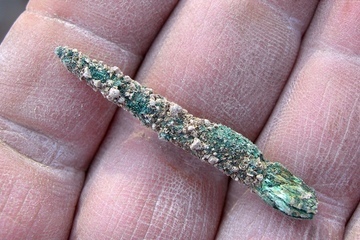
 A copper awl was discovered at the archaeological site Tel Tsaf in the Jordan Valley of Israel, dating to 5100 B.C. to 4600 B.C.
A copper awl was discovered at the archaeological site Tel Tsaf in the Jordan Valley of Israel, dating to 5100 B.C. to 4600 B.C.Credit: PLOS ONE, doi: 10.1371/journal.pone.0096882
A copper awl is the oldest metal object unearthed to date in the Middle East. The discovery reveals that metals were exchanged across hundreds of miles in this region more than 6,000 years ago, centuries earlier than previously thought, researchers say.
The artifact was unearthed in Tel Tsaf, an archaeological site in Israel located near the Jordan River and Israel's border with Jordan. The area was a village from about 5100 B.C. to 4600 B.C., and was first discovered in A.D. 1950, with digs taking place from the end of the 1970s up to the present day.
Tel Tsaf possessed large buildings made of mud bricks and a great number of silos that could each store 15 to 30 tons of wheat and barley, an unprecedented scale for the ancient Near East. The village had many roasting ovens in the courtyards, all filled with burnt animal bones, which suggests people held large events there. Moreover, scientists had unearthed items made of obsidian, a volcanic glass with origins in Anatolia or Armenia, as well as shells from the Nile River in Egypt and pottery from either Syria or Mesopotamia. All in all, these previous findings suggest this community was an ancient international center of commerce that possessed great wealth
Archaeologists discovered the cone-shaped awl in the grave of a woman who was about 40 years old when she died, and who had a belt around her waist made of 1,668 ostrich-egg shell beads. Several large stones covered the grave, which was dug inside a silo, suggesting both the woman and the silo were considered special.
The copper awl is about 1.6 inches (4.1 centimeters) long, about 0.2 inches (5 mm) wide at its base and just 0.03 inches (1 mm) wide at its tip. It was set in a wooden handle, and since it was buried with her, the researchers suggest the awl may have belonged to the woman.
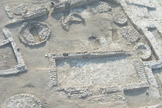
[image error]
 The courtyard building found at the Tel Tsaf archaeological site, with one of the silos, where a 40-year-old woman was buried inside a grave (upper left corner).
The courtyard building found at the Tel Tsaf archaeological site, with one of the silos, where a 40-year-old woman was buried inside a grave (upper left corner).Credit: PLOS ONE, doi: 10.1371/journal.pone.0096882
View full size image"The appearance of the item in a woman's grave, which represents one of the most elaborate burials we've seen in our region from that era, testifies to both the importance of the awl and the importance of the woman, and it's possible that we are seeing here the first indications of social hierarchy and complexity," study co-author Danny Rosenberg, an archaeologist at the University of Haifa in Israel, said in a statement.
Before this discovery, the earliest pieces of evidence for metal use in the ancient Near East were found in the southern Levant and included copper artifacts from the Nahal Mishmar cave and gold rings found inside the Nahal Qanah cave dating from 4500 B.C. to 3800 B.C. The awl suggests people in the area started using metals as early as 5100 B.C., several centuries earlier than previously thought. Chemical analysis of the copper also revealed it probably came from about 620 miles (1,000 kilometers) away, in the Caucasus region. This discovery suggests people in this area originally imported metal artifacts and only later created them locally.
The grave also shows "the complexity of the people living in Tel Tsaf around 7,000 years before present," Rosenberg told Live Science. "The find suggests that the people of Tel Tsaf were engaged in or at least had acquaintance with advanced technology, metallurgy, hundreds of years before the spread of copper items in the southern Levant."
The awl's use remains uncertain. "In this area, far more is unknown than is known, and although the discovery of the awl at Tel Tsaf constitutes evidence of a peak of technological development among the peoples of the region and is a discovery of global importance, there's a lot of progress still to be made and many parts of the wider picture are still unknown to us," Rosenberg said in a statement.
http://www.livescience.com/47501-oldest-metal-object-middle-east.html

Published on August 22, 2014 16:13
Humans Did Not Wipe Out the Neanderthals, New Research Suggests
By Charles Q. Choi,
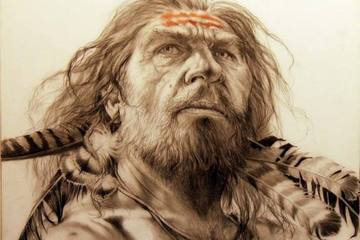
 Credit: Mauro Cutrona View full size image
Credit: Mauro Cutrona View full size image
Neanderthals went extinct in Europe about 40,000 years ago, giving them millennia to coexist with modern humans culturally and sexually, new findings suggest.
This research also suggests that modern humans did not cause Neanderthals to rapidly go extinct, as some researchers have previously suggested, scientists added.
Neanderthals are the closest extinct relatives of modern humans, and lived in Europe and Asia. Recent findings suggest that Neanderthals were closely related enough to interbreed with ancestors of modern humans — about 1.5 to 2.1 percent of the DNA of anyone outside Africa is Neanderthal in origin.
It has long been uncertain when Neanderthals went extinct, and there has been much debate over whether interactions with modern humans might have driven their disappearance. Neanderthals entered Europe before modern humans did, and prior studies had suggested the last of the Neanderthals held out there on the Iberian Peninsula until about 35,000 years ago, potentially sharing the region with modern humans for millennia. However, more recent findings suggested that some Neanderthal fossils from Europe might be thousands of years older than previously thought, raising the possibility that Neanderthals went extinct before modern humans arrived in Europe starting about 42,000 years ago. [The 10 Biggest Mysteries of the First Humans]
To help solve the mystery of when Neanderthals went extinct, scientists analyzed bone, charcoal and shell materials from 40 archaeological sites from Russia to Spain. They employed advanced techniques for more precise dating of these specimens that involved ultra-filtering molecules from bone samples for examination and removing organic contaminants that could make specimens seem younger than they actually are.
The new findings suggest that Neanderthals disappeared from Europe between about 41,000 and 39,000 years ago.
"I think that, for the first time, we have a reliable extinction date for Neanderthals," said study author Tom Higham, a radiocarbon scientist at the University of Oxford in England. "This has eluded us for decades."
The Neanderthal extinction occurred across sites ranging from the Black Sea to the Atlantic Coast of Europe. The timing and geography suggest Neanderthals may have overlapped with modern humans for 2,600 to 5,400 years, opening the door for genetic and cultural exchanges between the two groups for millennia.
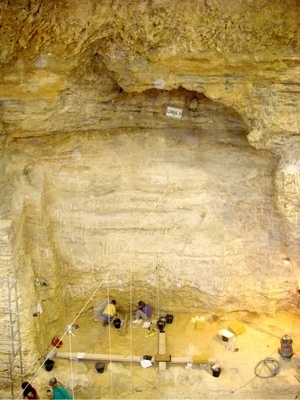
[image error] A site in Abric Romani, Spain, where Neanderthal remains were found.
A site in Abric Romani, Spain, where Neanderthal remains were found.
Credit: Thomas Higham
View full size imageThese findings suggest that modern humans did not rapidly replace Neanderthals in Europe — say, via violent means. Rather, the Neanderthal extinction "might have been more complex and drawn out than previously thought," Higham told Live Science.
There is some genetic evidence that Neanderthals in Western Europe may have experienced declining genetic diversity about the time when the first modern humans began arriving on the continent, Higham said. "This might mean that they were fading out at this time, although, of course, our evidence suggests that there was a long period of overlap during which this occurred," he said.
Neanderthals may not even have truly disappeared, but instead have been assimilated into modern human populations. "We know, of course, that we have a genetic legacy from Neanderthals of about 1 to 2 percent, so there was interbreeding," Higham said.
One mystery regarding sex between Neanderthals and modern humans is that the greatest amount of interbreeding between the two lineages is currently thought to have occurred about 77,000 to 114,000 years ago, preceding any potential interbreeding in Europe. However, Higham noted more recent as-yet-unpublished data suggest the interbreeding events occurred about 55,000 to 60,000 years ago, more in tune with interbreeding scenarios involving Europe. "What is needed is more genetic analysis of human bone from this transitional period in Europe," Higham said.
In the future, the researchers plan to extend their work into Eastern Europe and wider Eurasia to widen their data set and look for more patterns in the data pertaining to the Neanderthal extinction and the spread of modern humans, Higham said.
The scientists detailed their findings in the Aug. 21 issue of the journal Nature.
http://www.livescience.com/47460-neanderthal-extinction-revealed.html


 Credit: Mauro Cutrona View full size image
Credit: Mauro Cutrona View full size image Neanderthals went extinct in Europe about 40,000 years ago, giving them millennia to coexist with modern humans culturally and sexually, new findings suggest.
This research also suggests that modern humans did not cause Neanderthals to rapidly go extinct, as some researchers have previously suggested, scientists added.
Neanderthals are the closest extinct relatives of modern humans, and lived in Europe and Asia. Recent findings suggest that Neanderthals were closely related enough to interbreed with ancestors of modern humans — about 1.5 to 2.1 percent of the DNA of anyone outside Africa is Neanderthal in origin.
It has long been uncertain when Neanderthals went extinct, and there has been much debate over whether interactions with modern humans might have driven their disappearance. Neanderthals entered Europe before modern humans did, and prior studies had suggested the last of the Neanderthals held out there on the Iberian Peninsula until about 35,000 years ago, potentially sharing the region with modern humans for millennia. However, more recent findings suggested that some Neanderthal fossils from Europe might be thousands of years older than previously thought, raising the possibility that Neanderthals went extinct before modern humans arrived in Europe starting about 42,000 years ago. [The 10 Biggest Mysteries of the First Humans]
To help solve the mystery of when Neanderthals went extinct, scientists analyzed bone, charcoal and shell materials from 40 archaeological sites from Russia to Spain. They employed advanced techniques for more precise dating of these specimens that involved ultra-filtering molecules from bone samples for examination and removing organic contaminants that could make specimens seem younger than they actually are.
The new findings suggest that Neanderthals disappeared from Europe between about 41,000 and 39,000 years ago.
"I think that, for the first time, we have a reliable extinction date for Neanderthals," said study author Tom Higham, a radiocarbon scientist at the University of Oxford in England. "This has eluded us for decades."
The Neanderthal extinction occurred across sites ranging from the Black Sea to the Atlantic Coast of Europe. The timing and geography suggest Neanderthals may have overlapped with modern humans for 2,600 to 5,400 years, opening the door for genetic and cultural exchanges between the two groups for millennia.

[image error]
 A site in Abric Romani, Spain, where Neanderthal remains were found.
A site in Abric Romani, Spain, where Neanderthal remains were found.Credit: Thomas Higham
View full size imageThese findings suggest that modern humans did not rapidly replace Neanderthals in Europe — say, via violent means. Rather, the Neanderthal extinction "might have been more complex and drawn out than previously thought," Higham told Live Science.
There is some genetic evidence that Neanderthals in Western Europe may have experienced declining genetic diversity about the time when the first modern humans began arriving on the continent, Higham said. "This might mean that they were fading out at this time, although, of course, our evidence suggests that there was a long period of overlap during which this occurred," he said.
Neanderthals may not even have truly disappeared, but instead have been assimilated into modern human populations. "We know, of course, that we have a genetic legacy from Neanderthals of about 1 to 2 percent, so there was interbreeding," Higham said.
One mystery regarding sex between Neanderthals and modern humans is that the greatest amount of interbreeding between the two lineages is currently thought to have occurred about 77,000 to 114,000 years ago, preceding any potential interbreeding in Europe. However, Higham noted more recent as-yet-unpublished data suggest the interbreeding events occurred about 55,000 to 60,000 years ago, more in tune with interbreeding scenarios involving Europe. "What is needed is more genetic analysis of human bone from this transitional period in Europe," Higham said.
In the future, the researchers plan to extend their work into Eastern Europe and wider Eurasia to widen their data set and look for more patterns in the data pertaining to the Neanderthal extinction and the spread of modern humans, Higham said.
The scientists detailed their findings in the Aug. 21 issue of the journal Nature.
http://www.livescience.com/47460-neanderthal-extinction-revealed.html

Published on August 22, 2014 16:05
2,800-Year-Old Zigzag Art Found in Greek Tomb
By Owen Jarus,
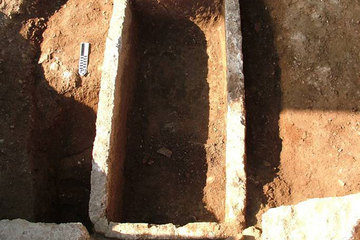
 A 2,800-year-old tomb with the remains of a possibly wealthy individual inside, has been discovered in the ancient city of Corinth in Greece.
A 2,800-year-old tomb with the remains of a possibly wealthy individual inside, has been discovered in the ancient city of Corinth in Greece.
Credit: Photo courtesy American School of Classical Studies
Archaeologists working at the ancient city of Corinth, Greece, have discovered a tomb dating back around 2,800 years that has pottery decorated with zigzagging designs.
The tomb was built sometime between 800 B.C. and 760 B.C., a time when Corinth was emerging as a major power and Greeks were colonizing the coasts of the Mediterranean Sea.
The tomb itself consists of a shaft and burial pit, the pit having a limestone sarcophagus that is about 5.8 feet (1.76 meters) long, 2.8 feet (0.86 m) wide and 2.1 feet (0.63 m) high. When researchers opened the sarcophagus, they found a single individual had been buried inside, with only fragments of bones surviving.
The scientists found several pottery vessels beside the sarcophagus, and the tomb also contained a niche, sealed with a limestone slab, which held 13 mostly complete vessels.
"The wealth of the occupant here is indicated by the sarcophagus and the large number of vessels," writes a team of researchers in a recent issue of the journal Hesperia. Except for two vessels imported from Athens all the pottery was made in Corinth, the researchers noted.
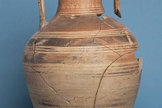
[image error] A jar decorated with zigzagging lines was found beside the sarcophagus inside the 2,800-year-old Greek tomb.
A jar decorated with zigzagging lines was found beside the sarcophagus inside the 2,800-year-old Greek tomb.
Credit: Photo courtesy American School of Classical Studies
View full size imageThe vessels were decorated with a variety of designs, including wavy, zigzagging lines and meandering patterns that look like a maze. This style of pottery was popular at the time, and archaeologists often refer to this as Greece's "Geometric" period.
Several centuries later, in Roman times, the tomb would almost be destroyed after a wall was built beside it. When archaeologists excavated that wall, they found a limestone column that may have originally served as a grave marker for the tomb.
Rise of a wealthy city
A group of rulers called the Bacchiadae came to power in Corinth in 747 B.C. (a few decades after the tomb was constructed), ancient records indicate. Those rulers built colonies in modern-day Sicily and Corfu, decisions that helped Corinth increase trade and grow wealthy.
"Once these colonies in the west and northwest had been established, Corinth, because of its favorable geographical location, became the most important trading center for commerce between them and mainland Greece," wrote Elke Stein-Hölkeskamp, an instructor at the University of Münster in Germany, in a paper published in the book "A Companion to Archaic Greece" (Wiley-Blackwell, 2009).
Corinthian goods, including the city's fine pottery, would be traded throughout the Mediterranean world.
The tomb was found in 2006 during excavations done by the American School of Classical Studies in a part of Corinth now called the Panayia Field. A report on the tomb was published recently in the journal Hesperia. Four other graves had been found close to this tomb before 2006.
http://www.livescience.com/47457-greek-tomb-art-discovered.html

 A 2,800-year-old tomb with the remains of a possibly wealthy individual inside, has been discovered in the ancient city of Corinth in Greece.
A 2,800-year-old tomb with the remains of a possibly wealthy individual inside, has been discovered in the ancient city of Corinth in Greece.Credit: Photo courtesy American School of Classical Studies
Archaeologists working at the ancient city of Corinth, Greece, have discovered a tomb dating back around 2,800 years that has pottery decorated with zigzagging designs.
The tomb was built sometime between 800 B.C. and 760 B.C., a time when Corinth was emerging as a major power and Greeks were colonizing the coasts of the Mediterranean Sea.
The tomb itself consists of a shaft and burial pit, the pit having a limestone sarcophagus that is about 5.8 feet (1.76 meters) long, 2.8 feet (0.86 m) wide and 2.1 feet (0.63 m) high. When researchers opened the sarcophagus, they found a single individual had been buried inside, with only fragments of bones surviving.
The scientists found several pottery vessels beside the sarcophagus, and the tomb also contained a niche, sealed with a limestone slab, which held 13 mostly complete vessels.
"The wealth of the occupant here is indicated by the sarcophagus and the large number of vessels," writes a team of researchers in a recent issue of the journal Hesperia. Except for two vessels imported from Athens all the pottery was made in Corinth, the researchers noted.

[image error]
 A jar decorated with zigzagging lines was found beside the sarcophagus inside the 2,800-year-old Greek tomb.
A jar decorated with zigzagging lines was found beside the sarcophagus inside the 2,800-year-old Greek tomb.Credit: Photo courtesy American School of Classical Studies
View full size imageThe vessels were decorated with a variety of designs, including wavy, zigzagging lines and meandering patterns that look like a maze. This style of pottery was popular at the time, and archaeologists often refer to this as Greece's "Geometric" period.
Several centuries later, in Roman times, the tomb would almost be destroyed after a wall was built beside it. When archaeologists excavated that wall, they found a limestone column that may have originally served as a grave marker for the tomb.
Rise of a wealthy city
A group of rulers called the Bacchiadae came to power in Corinth in 747 B.C. (a few decades after the tomb was constructed), ancient records indicate. Those rulers built colonies in modern-day Sicily and Corfu, decisions that helped Corinth increase trade and grow wealthy.
"Once these colonies in the west and northwest had been established, Corinth, because of its favorable geographical location, became the most important trading center for commerce between them and mainland Greece," wrote Elke Stein-Hölkeskamp, an instructor at the University of Münster in Germany, in a paper published in the book "A Companion to Archaic Greece" (Wiley-Blackwell, 2009).
Corinthian goods, including the city's fine pottery, would be traded throughout the Mediterranean world.
The tomb was found in 2006 during excavations done by the American School of Classical Studies in a part of Corinth now called the Panayia Field. A report on the tomb was published recently in the journal Hesperia. Four other graves had been found close to this tomb before 2006.
http://www.livescience.com/47457-greek-tomb-art-discovered.html

Published on August 22, 2014 15:57
King Richard III Feasted on Wine and Swans
 by Rossella Lorenzi
by Rossella Lorenzi In the last three years of his life, King Richard III consumed up to three liters of alcohol per day and feasted on swan, egret and heron, analysis of the monarch’s teeth and bones has revealed.
Researchers from the British Geological Survey and the University of Leicester examined changes in chemistry in the bones of the last Plantagenet king, whose remains were found buried beneath a parking lot in the English city of Leicester in 2012.
“We applied multi-element isotope techniques to reconstruct a full life history,” Angela Lamb, isotope geochemist at the British Geological Survey, Richard Buckley from the University of Leicester Archaeological Services, and colleagues wrote in the latest issue of the Journal of Archaeological Science.
Richard III Clouded by Fiction: A History
Born in Northamptonshire in 1452, Richard became King of England in 1483 at the age of 30, ruling for just two years and two months.
The king, depicted by William Shakespeare as a bloodthirsty usurper, was killed in 1485 in the Battle of Bosworth, which was the last act of the decades-long fight over the throne known as War of the Roses. He was defeated by Henry Tudor, who became King Henry VII.
The researchers measured the levels of certain chemicals, such as strontium, nitrogen, oxygen, carbon and lead that relate to geographical location, pollution and diet in three locations on the skeleton of Richard III.
They analyzed bioapatite and collagen from sections of two teeth, which formed during childhood and early adolescence, and from two bones: the femur, which represents an average of the 15 years before death, and the rib, which remodels faster and represents between 2 and 5 years of life before death.
“The isotopes initially concur with Richard’s known origins in Northamptonshire, but suggest that he had moved out of eastern England by age seven, and resided further west, possibly the Welsh Marches,” the researchers wrote.
Face of Richard III Reconstructed
The isotope changes became evident between Richard’s femur and rib bones, revealing “a significant shift” in the nitrogen isotope values towards the end of Richard life, coinciding directly with his time as King of England.
The shift would correspond to an increase in consumption of luxury items such as game birds (swans, herons, egret) and freshwater fish.
“The Late Medieval diet of an aristocrat consisted of bread, ale, meat, fish, wine and spices with a strong correlation between wealth and the relative proportions of these, with more wine and spices and proportionally less ale and cereals with increasing wealth,” the researchers said.
Another significant shift was recorded in Richard’s oxygen isotope values, which also rose towards the end of his life.
“As we know he did not relocate during this time, we suggest the changes could be brought about by increased wine consumption,” Lamb and colleagues wrote.
Richard III May Have Had a Brummie Accent
The analysis showed there was a 25 percent increase in Richard’s consumption of wine when he became king.
This would equal to a bottle of wine per day, in addition to the large quantities of beer most medieval men consumed at that time, giving Richard an overall alcohol consumption of two to three liters per day.
Indeed, Richard began to indulge in food and wine since his coronation banquet, noted for being particularly long and elaborate. The excesses are likely to have continued throughout his short lived reign.
“It is not unexpected that his consumption of wine and rich foods increased over the last few years of his life,” the researchers wrote.
Richard III will be finally reburied in Leicester Cathedral on March 26, 2015 at the end of a seven-day program of events in Leicester and Leicestershire to honor the king.
Image: Late 16th century portrait of Richard III, housed in the National Portrait Gallery, London. Credt: Wikimedia Commons.
http://news.discovery.com/history/archaeology/king-richard-iii-feasted-on-wine-and-swans-140818.htm

Published on August 22, 2014 15:49
Jesus Statue Found to Have Real Human Teeth
by Tia Ghose
 A Jesus statue that has lived an unassuming life in a small town in Mexico for the last 300 years has been hiding a strange secret: real human teeth.
A Jesus statue that has lived an unassuming life in a small town in Mexico for the last 300 years has been hiding a strange secret: real human teeth.
Exactly how the statue of Jesus awaiting punishment prior to his crucifixion got its set of choppers is a mystery.
But the statue may be an example of a tradition in which human body parts were donated to churches for religious purposes, said Fanny Unikel Santoncini, a restorer at the Escuela Nacional de Restauración, Conservación y Museografía at the Instituto Nacional de Antropología E Historia (INAH) in Mexico, who first discovered the statue's teeth.
Why People Believe Jesus Had a Wife An ancient text claims that Jesus had a wife. Ross Everett joins DNews to report on this new finding. "We have to remember that these people were very, very religious. They believed absolutely that there was a life after death and this was important for them," Unikel told Live Science. [See Images of the Jesus Statue with Human Teeth]
Unassuming appearance
At first glance, the Christ of Patience — which depicts a seated, bloody Jesus gazing sadly off into the distance — doesn't look that different from statues found throughout the country. The painted wooden figure, which dates to the 17th or 18th century, wears human clothes and a wig, and was sculpted with a blend of European techniques and local materials, Unikel said.
"In Mexico, there are many statues like this — not only Christ, but Saints, the Virgin Mary," Unikel said.
Using human and animal body parts for statues isn't unusual either. People routinely donated hair to serve as wigs for statues, and artists often used nails fashioned from the shaved horns of bulls, she said.
Statues in Mexico are known to include false teeth made from animal bone — either with all the teeth carved from one solid piece of bone, or with individual, square-shaped teeth. A statue of the devil may be given a set of dog's teeth, and the team has even restored a baby Jesus statue with two baby rabbit teeth sprouting from its gums, Unikel said. But though there were rumors about a few statues containing human teeth, Unikel had never seen one.
God's teeth
The discovery happened by accident, when the Christ of Patience was taken, along with several other statues, to be restored by the INAH researchers.
As part of their restoration work, Unikel and her colleagues took X-rays of the statues. The anthropologist on the team noticed something unusual: real human teeth.
"We said 'Ah, it's not possible!'" Unikel told Live Science. "She said, 'I am absolutely sure about this.'"
The pearly whites seemed to be in good condition, with even the roots present. The finding is even stranger in that someone would donate such healthy teeth for the statue given that the statue's mouth is barely open, and the teeth aren't even visible unless someone peers inside, Unikel said.
Finding the owner
The teeth could have come from living or dead people, but with no available documents describing the statue, scientists and restorers will have a tough time tracking down the original owner. One possibility is that a particularly devout parishioner, or even many different people, donated the teeth. Another possibility is that someone extracted the teeth from an unwilling victim, but if so, the sculptor would never have revealed that fact, Unikel said. [Religious Mysteries: 8 Alleged Relics of Jesus]
Donating body parts to a church or religious cause was common practice during the late 17th and 18th centuries. For instance, the Bishop of Guadalajara, Obispo Manuel Fernández de Santa Cruz, donated his heart to the nuns of Convento de Santa Mónica de Puebla after he died in 1699. The heart was visible in a monstrance that only the nuns could see, Unikel said. And a Spanish government minister, Viceroy Baltazar de Zúñiga, Marquez de Valero also donated his heart to a convent of nuns, she said.
"For us, it seems mad," Unikel said, referring to people in modern times. But "the way they thought about the body was different from ours."
Now the researchers would like to find out more about the mysterious person or people who donated these teeth. Though they can't remove the teeth from the religious statue, the researchers hope to study them more carefully to figure out the age and sex of the teeth's owners, she said.
http://news.discovery.com/history/art-history/jesus-statue-found-to-have-real-human-teeth-140818.htm
 A Jesus statue that has lived an unassuming life in a small town in Mexico for the last 300 years has been hiding a strange secret: real human teeth.
A Jesus statue that has lived an unassuming life in a small town in Mexico for the last 300 years has been hiding a strange secret: real human teeth.Exactly how the statue of Jesus awaiting punishment prior to his crucifixion got its set of choppers is a mystery.
But the statue may be an example of a tradition in which human body parts were donated to churches for religious purposes, said Fanny Unikel Santoncini, a restorer at the Escuela Nacional de Restauración, Conservación y Museografía at the Instituto Nacional de Antropología E Historia (INAH) in Mexico, who first discovered the statue's teeth.
Why People Believe Jesus Had a Wife An ancient text claims that Jesus had a wife. Ross Everett joins DNews to report on this new finding. "We have to remember that these people were very, very religious. They believed absolutely that there was a life after death and this was important for them," Unikel told Live Science. [See Images of the Jesus Statue with Human Teeth]
Unassuming appearance
At first glance, the Christ of Patience — which depicts a seated, bloody Jesus gazing sadly off into the distance — doesn't look that different from statues found throughout the country. The painted wooden figure, which dates to the 17th or 18th century, wears human clothes and a wig, and was sculpted with a blend of European techniques and local materials, Unikel said.
"In Mexico, there are many statues like this — not only Christ, but Saints, the Virgin Mary," Unikel said.
Using human and animal body parts for statues isn't unusual either. People routinely donated hair to serve as wigs for statues, and artists often used nails fashioned from the shaved horns of bulls, she said.
Statues in Mexico are known to include false teeth made from animal bone — either with all the teeth carved from one solid piece of bone, or with individual, square-shaped teeth. A statue of the devil may be given a set of dog's teeth, and the team has even restored a baby Jesus statue with two baby rabbit teeth sprouting from its gums, Unikel said. But though there were rumors about a few statues containing human teeth, Unikel had never seen one.
God's teeth
The discovery happened by accident, when the Christ of Patience was taken, along with several other statues, to be restored by the INAH researchers.
As part of their restoration work, Unikel and her colleagues took X-rays of the statues. The anthropologist on the team noticed something unusual: real human teeth.
"We said 'Ah, it's not possible!'" Unikel told Live Science. "She said, 'I am absolutely sure about this.'"
The pearly whites seemed to be in good condition, with even the roots present. The finding is even stranger in that someone would donate such healthy teeth for the statue given that the statue's mouth is barely open, and the teeth aren't even visible unless someone peers inside, Unikel said.
Finding the owner
The teeth could have come from living or dead people, but with no available documents describing the statue, scientists and restorers will have a tough time tracking down the original owner. One possibility is that a particularly devout parishioner, or even many different people, donated the teeth. Another possibility is that someone extracted the teeth from an unwilling victim, but if so, the sculptor would never have revealed that fact, Unikel said. [Religious Mysteries: 8 Alleged Relics of Jesus]
Donating body parts to a church or religious cause was common practice during the late 17th and 18th centuries. For instance, the Bishop of Guadalajara, Obispo Manuel Fernández de Santa Cruz, donated his heart to the nuns of Convento de Santa Mónica de Puebla after he died in 1699. The heart was visible in a monstrance that only the nuns could see, Unikel said. And a Spanish government minister, Viceroy Baltazar de Zúñiga, Marquez de Valero also donated his heart to a convent of nuns, she said.
"For us, it seems mad," Unikel said, referring to people in modern times. But "the way they thought about the body was different from ours."
Now the researchers would like to find out more about the mysterious person or people who donated these teeth. Though they can't remove the teeth from the religious statue, the researchers hope to study them more carefully to figure out the age and sex of the teeth's owners, she said.
http://news.discovery.com/history/art-history/jesus-statue-found-to-have-real-human-teeth-140818.htm

Published on August 22, 2014 15:43
History Trivia - St. Columba reports seeing a monster in Loch Ness, Scotland.
August 22

392 Arbogast (Frankish general of the Roman Empire) had Eugenius (a Christian who was the last Emperor to support Roman polytheism) elected Western Roman Emperor.

476 Odoacer was named Rex Italia (King of Italy)) by his troops. His reign is commonly seen as marking the end of the classical Roman Empire in Western Europe and the beginning of the Middle Ages.
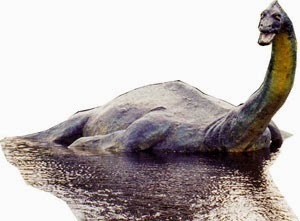
565 St. Columba reported seeing a monster in Loch Ness, Scotland.

851 Erispoe, King of Brittany, defeated Charles the Bald near the Breton town of Jengland.
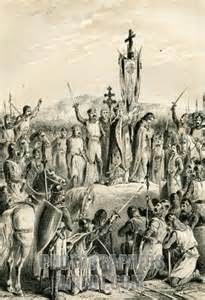
1138 Battle of the Standard where English forces repelled the Scottish army led by King David I of Scotland.

1485 Richard III was killed at the Battle of Bosworth and Henry VII became the first king of the Tudor dynasty.

1642 Charles I raises the royal standard at Nottingham, igniting the English Civil War.


392 Arbogast (Frankish general of the Roman Empire) had Eugenius (a Christian who was the last Emperor to support Roman polytheism) elected Western Roman Emperor.

476 Odoacer was named Rex Italia (King of Italy)) by his troops. His reign is commonly seen as marking the end of the classical Roman Empire in Western Europe and the beginning of the Middle Ages.

565 St. Columba reported seeing a monster in Loch Ness, Scotland.

851 Erispoe, King of Brittany, defeated Charles the Bald near the Breton town of Jengland.

1138 Battle of the Standard where English forces repelled the Scottish army led by King David I of Scotland.

1485 Richard III was killed at the Battle of Bosworth and Henry VII became the first king of the Tudor dynasty.

1642 Charles I raises the royal standard at Nottingham, igniting the English Civil War.

Published on August 22, 2014 05:10
August 21, 2014
History Trivia - Dundee's rising
August 21

1165 Philip II (Philip Augustus) the first king of the Capetian dynasty in France was born.

1689 The Battle of Dunkeld in Scotland was fought between Jacobite clans supporting the deposed king James VII of Scotland and a government regiment of covenanters supporting William of Orange, King of Scotland, in the streets around Dunkeld Cathedral, Dunkeld, Scotland, and formed part of the Jacobite rising commonly called Dundee's rising in Scotland.


1165 Philip II (Philip Augustus) the first king of the Capetian dynasty in France was born.

1689 The Battle of Dunkeld in Scotland was fought between Jacobite clans supporting the deposed king James VII of Scotland and a government regiment of covenanters supporting William of Orange, King of Scotland, in the streets around Dunkeld Cathedral, Dunkeld, Scotland, and formed part of the Jacobite rising commonly called Dundee's rising in Scotland.

Published on August 21, 2014 05:22
August 20, 2014
In the Midst: Vintage book with #audio...
In the Midst: Vintage book with #audio...: Vintage books with Audio..... Today, I was shopping at a used book store. When I walked in the store I took a deep breath inh...
Vintage book with #audio...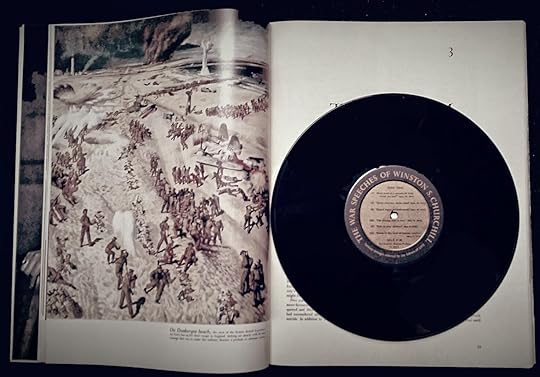

Vintage books with Audio.....
Today, I was shopping at a used book store. When I walked in the store I took a deep breath inhaling the scent of ink posted to paper. It was the best smell ever. Yes, I am a book lover. As I walked past rows and rows of books from floor to ceiling, I didn’t want to have to leave….ever. But I did, and I wound up going to another store and then, yet, another.
And hidden in the midst of several stores and thousands of books was the one that caught my eye. It was published in the early 1900’s and what surprised me the most about this find that I could not afford, was the record that was situated in between its pages.
Could you say this was the first attempt at adding audio to books? It wasn’t an audio of the book, but an addition. Speeches. Was the publishing company looking forward to the time when books would be available in audio or was this a fluke? I don’t know but I couldn’t resist taking pictures of the book and record that I couldn’t afford. J
Moving on into the present day, are you a reader? Do you listen to audio books? Are you an author? Have you considered putting your books to audio?
I have recently journeyed down the path of audio with my books. Thanks to the electronic industry and the world wide web, I was able to put six of my books on audio by the end on September 2014.
Their Journey Begins is an historical anthology. Click here for Audible. Click here for ITunes.
Transcendence is spiritual poetry. Click here for Audible. Click here for ITunes.
On Top of the Rainbow is for children. Click here for Audible. Click here for ITunes.
Encima Del Arco Iris is for children. (coming soon)
Princess Alexia and the Dragon is for children. Click here for Audible. Click here for ITunes
La Princesa y el Dragon is for children.(coming soon)
Audible Link ITunes Link
All will be available both on Audible and ITunes by the end of September 2014. Their Journey Begins, Transcendence, On Top of the Rainbow, and Princess Alexia and the Dragon is available now.
 Author K. Meador is a mom to two grown sons who are currently pursuing their adult lives outside the home. For the past several years, she has traveled with her job and has now settled down in Oklahoma City area.
Author K. Meador is a mom to two grown sons who are currently pursuing their adult lives outside the home. For the past several years, she has traveled with her job and has now settled down in Oklahoma City area.
She enjoys photography, walking, and visiting with family and friends.
Please leave a comment on this blog and share if you are so inclined. Author K. Meador has six books published which are available in paperback, eBook, and four are on audio. Thank you. Your support is truly appreciated.
www.authorkmeador.com US Amazon Link UK Amazon Link
Vintage book with #audio...


Vintage books with Audio.....
Today, I was shopping at a used book store. When I walked in the store I took a deep breath inhaling the scent of ink posted to paper. It was the best smell ever. Yes, I am a book lover. As I walked past rows and rows of books from floor to ceiling, I didn’t want to have to leave….ever. But I did, and I wound up going to another store and then, yet, another.
And hidden in the midst of several stores and thousands of books was the one that caught my eye. It was published in the early 1900’s and what surprised me the most about this find that I could not afford, was the record that was situated in between its pages.
Could you say this was the first attempt at adding audio to books? It wasn’t an audio of the book, but an addition. Speeches. Was the publishing company looking forward to the time when books would be available in audio or was this a fluke? I don’t know but I couldn’t resist taking pictures of the book and record that I couldn’t afford. J
Moving on into the present day, are you a reader? Do you listen to audio books? Are you an author? Have you considered putting your books to audio?
I have recently journeyed down the path of audio with my books. Thanks to the electronic industry and the world wide web, I was able to put six of my books on audio by the end on September 2014.
Their Journey Begins is an historical anthology. Click here for Audible. Click here for ITunes.
Transcendence is spiritual poetry. Click here for Audible. Click here for ITunes.
On Top of the Rainbow is for children. Click here for Audible. Click here for ITunes.
Encima Del Arco Iris is for children. (coming soon)
Princess Alexia and the Dragon is for children. Click here for Audible. Click here for ITunes
La Princesa y el Dragon is for children.(coming soon)
Audible Link ITunes Link
All will be available both on Audible and ITunes by the end of September 2014. Their Journey Begins, Transcendence, On Top of the Rainbow, and Princess Alexia and the Dragon is available now.
 Author K. Meador is a mom to two grown sons who are currently pursuing their adult lives outside the home. For the past several years, she has traveled with her job and has now settled down in Oklahoma City area.
Author K. Meador is a mom to two grown sons who are currently pursuing their adult lives outside the home. For the past several years, she has traveled with her job and has now settled down in Oklahoma City area.She enjoys photography, walking, and visiting with family and friends.
Please leave a comment on this blog and share if you are so inclined. Author K. Meador has six books published which are available in paperback, eBook, and four are on audio. Thank you. Your support is truly appreciated.
www.authorkmeador.com US Amazon Link UK Amazon Link

Published on August 20, 2014 05:54



